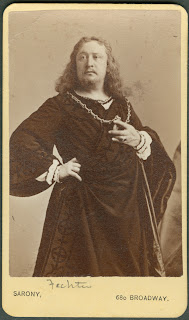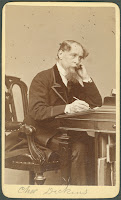
The elaborate and often arcane rules of etiquette in the nineteenth century demanded the proper use of calling cards when visiting or "calling on" an acquaintance. These cards were very like modern business cards and it was customary for a visitor to leave his or her card as a prelude to a visit. If they then received a card from the acquaintance, that meant that they were welcome to return. No return card was a message that a visit was discouraged - an early equivalent of temporarily un-friending someone. During the nineteenth century, the well mannered - and perhaps slightly vain - visitor might send in a carte de visite - a small, typically albumen type photograph measuring about 2 x 3.5 inches (the size of a standard calling card) mounted on thick paper, which often highlighted some important or characteristic aspect of the caller's life. This card shows actor Charles Fechter as Hamlet - a role he was famous for.
Due in part to the relatively low cost of production (eight carte de visites could be produced from one plate) and the early publication of Napoleon III's photo in this small format, carte de visites became extremely popular. Like more recent baseball trading cards, those of famous people were collected, traded, and displayed. A collection of impressive carte de visites was considered to be an asset for every Victorian household and specially made albums were sold to house and display the collected images. This small collection of forty-five cards includes those of then Prince of Wales Edward VII and Princess Alexandra, Mark Twain, Louisa May Alcott, Nathaniel Hawthorne, Charles Dickens and opera singer Christina Nilsson.
 |
| Edward VII & Alexandra |
 |
| Louisa May Alcott |
 |
| Mark Twain |
 |
| Nathaniel Hawthorne |
 |
| Christina Nilsson |
 |
| Charles Dickens |
Ask for
Iconography 1394.
 The elaborate and often arcane rules of etiquette in the nineteenth century demanded the proper use of calling cards when visiting or "calling on" an acquaintance. These cards were very like modern business cards and it was customary for a visitor to leave his or her card as a prelude to a visit. If they then received a card from the acquaintance, that meant that they were welcome to return. No return card was a message that a visit was discouraged - an early equivalent of temporarily un-friending someone. During the nineteenth century, the well mannered - and perhaps slightly vain - visitor might send in a carte de visite - a small, typically albumen type photograph measuring about 2 x 3.5 inches (the size of a standard calling card) mounted on thick paper, which often highlighted some important or characteristic aspect of the caller's life. This card shows actor Charles Fechter as Hamlet - a role he was famous for.
The elaborate and often arcane rules of etiquette in the nineteenth century demanded the proper use of calling cards when visiting or "calling on" an acquaintance. These cards were very like modern business cards and it was customary for a visitor to leave his or her card as a prelude to a visit. If they then received a card from the acquaintance, that meant that they were welcome to return. No return card was a message that a visit was discouraged - an early equivalent of temporarily un-friending someone. During the nineteenth century, the well mannered - and perhaps slightly vain - visitor might send in a carte de visite - a small, typically albumen type photograph measuring about 2 x 3.5 inches (the size of a standard calling card) mounted on thick paper, which often highlighted some important or characteristic aspect of the caller's life. This card shows actor Charles Fechter as Hamlet - a role he was famous for. 





Alexandra
ReplyDeleteThanks--we fixed it.
Delete